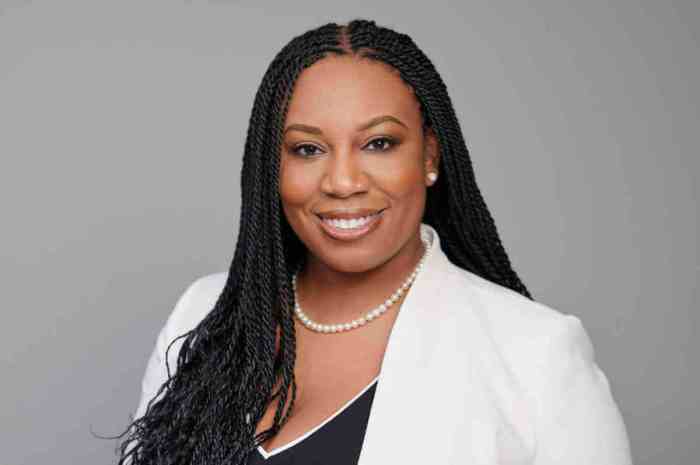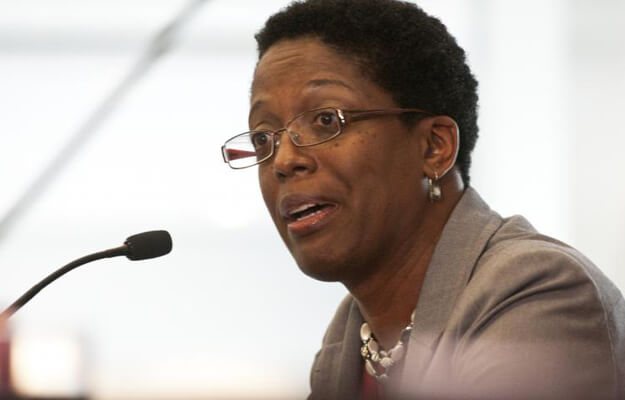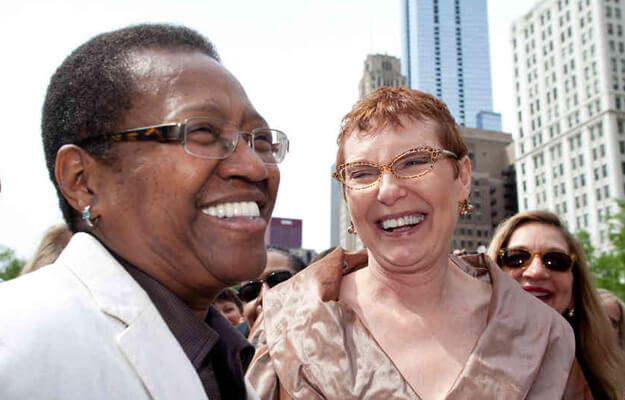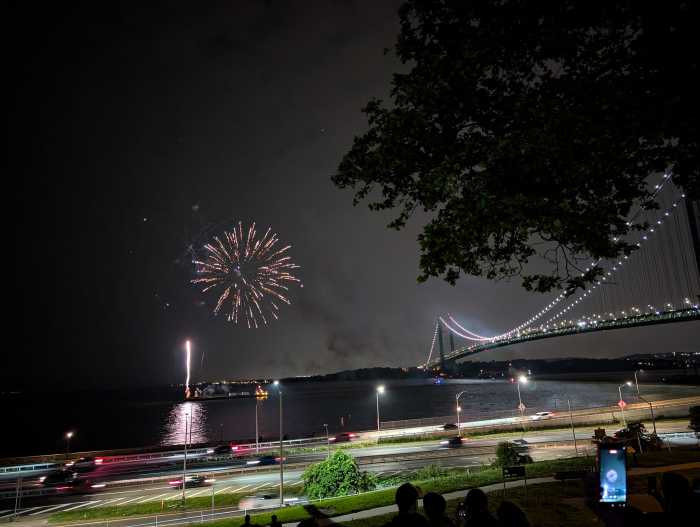UNIVERSITY OF WISCONSIN PRESS
Queers have sought the freedom and anonymity of cities as long as cities have existed, and unearthing our hidden urban homosexual history is critical to an understanding of our community’s culture. While New York’s s queer past has been amply and excellently chronicled in studies by George Chauncey and Charles Kaiser and amplified in dozens of biographies and novels, the story of sexual dissidents in Chicago has remained largely unexplored.
But now the University of Wisconsin Press has published “Chicago Whispers: A History of LGBT Chicago Before Stonewall,” by St. Sukie de la Croix, the nom de plume of Darryl Michael Vincent, a British-born journalist for the gay press who has lived in and chronicled queer Chicago since 1991.
“Chicago Whispers” details how, as early as the Civil War — when Chicago became a major supply base and headquarters for the Union Army — a 60-plus-room sex spa called Under the Willows included cubicles rented to male prostitutes.
St. Sukie de la Croix brings to life 19th, 20th century queer life in the Windy City
By the end of the 19th century, the city’s First Ward — which encompassed the Levee District, the city’s “red light” vice axis — was represented by Alderman “Bathhouse John” Coughlin, a former “rubber” in a gay bathhouse who owned several Turkish baths notorious as queer gathering and trysting places. From 1896 to 1908, “Bathhouse John” hosted the First Ward Ball, an “annual debauchery” featuring prostitutes of both sexes and female impersonators. Staging the ball involved a shakedown of the First Ward’s saloon and brothel keepers, who were forced to buy tickets to it, thereby filling Bathhouse John’s campaign coffers.
But the “largest commercialized vice district into the country” was doomed when a “fire-breathing evangelist” preacher led a crowd of 15,000 in a march on the district to demand a crackdown. A Vice Commission was established and nightly raids on the “dens of perversion” followed. The last brothel closed in 1914, according to de la Croix.
Female and male impersonators were all the rage in the Chicago music halls in the last quarter of the 19th century, and de la Croix gives us portraits of a number of them.
Another important feature of Chicago queer culture was its African-American blues and jazz scene, and the number of singer-songwriters who made reference to homosexuals and lesbians in their songs is truly astonishing. De la Croix quotes the lyrics to quite a few of these ditties, like “Sissy Man Blues,” which crooned:
I woke up this morning with my ‘poor kinda business’ in my hand
God, if you can’t send me no woman,
Then send me a sissy man
But how many of us know that the sentimental standard “Pretty Baby” — featured in the 1951 Doris Day movie “I’ll See You In My Dreams” — was originally written by openly gay singer Tony Jackson as a song to his male lover?
“Performing was one of the few ways that African-American women, especially lesbians, could be financially independent,” which helps explain the large number of lesbian blues and jazz singers from Chicago, from Alberta Hunter to Ethel Waters.
The Little Review, an influential Chicago literary magazine founded by lesbian Margaret Anderson and her partner, Djuna Barnes, published Ernest Hemingway and a host of gay and bisexual writers like the cigar-smoking Imagist poet Amy Lowell, Witter Bynner, Hart Crane, Max Bodenheim, and the black poet Mark Turbyfill.
The chapter on the Little Review is one of the best in the book — with one exception. De la Croix asserts that a 1915 Chicago lecture by Edith Ellis, the British novelist and wife of pro-gay sexologist Havelock Ellis, was “the first in America to call for equal rights and tolerance of homosexuality.” That’s plain wrong, since such a discourse had long been a feature of American anarchism since the trial of Oscar Wilde two decades earlier, as the San Francisco gay historian Terence Kissack demonstrated in his important 2008 book, “Free Comrades: Anarchism and Homosexuality in the United States, 1895-1917.” Indeed, homosexuality and sexual freedom had been a staple in the packed lectures of anarchist leader Emma Goldman (whom de la Croix cites on several occasions in his book) for years before Ellis’ talk.
But de la Croix is on firmer ground with his finely-researched portrait of Henry Gerber, the Chicago postal clerk who in 1924 founded America’s first gay rights organization, the Society for Human Rights (SHR).
The German-born Gerber later recalled that it was while serving in World War I as an editor of a US army newspaper for the troops stationed in Germany that he discovered Magnus Hirschfeld, the pioneer German homosexual liberationist, and his Scientific Humanitarian Committee in defense of queer rights. Gerber managed to publish two issues of the SHR newsletter Friendship and Freedom before he and SHR’s secretary were arrested in a police raid. Gerber’s diaries, illegally seized by police, contained the incriminating phrase “I love Karl.” Following his arrest, Gerber was suspended from the post office, and the SHR came to end.
But Gerber continued, and in 1930 founded Contacts, a mimeographed monthly newsletter that served as a meeting place for homosexuals. By then, he had re-enlisted in the army, in which he served for 21 years, retiring with the rank of staff sergeant in 1945. Gerber’s lonely combat on behalf of gays is still an inspirational one. In 2001, Gerber’s home on North Crilly Court was declared an official Chicago Landmark.
“Chicago Whispers” is filled with stories, including many first-person accounts of queer parties, balls, and nightclubs in the first several decades of the 20th century, that bring back to us the lively and extensive same-sex culture that flourished in those years in the Second City.
For example, in 1930 the entertainment paper Variety featured an article on the city’s “pansy craze” that declared, “America’s toughest city is going pansy, and liking it. Within the past six months some 35 new dim lit tearooms, created by boys who won’t throw open the doors until at least two hours have been spent adjusting the drapes just so, have opened on the near North Side… All the waitresses are lads in girls clothing… Racketeers, who have made the near North Side their playground for some years, have gone strong for these boy joints in a big way…”
Indeed, de la Croix tells us that one of Al Capone’s closest associates was a same-sexer, and Capone pal Jake “Greasy Thumb” Guzik, who remained the mob’s bookkeeper long after Capone’s 1947 death, was part-owner of the Windup Lounge, a much-raided gay club in the ‘30s and ‘40s. Eighty-seven people were arrested there in one 1949 police raid.
De la Croix’s book began as a series of articles in Tracy Baim’s fine queer weekly, the Windy City Times, and from there he wangled a 10-part series on the city’s queer history for the Chicago Triune. That means that many of these chapters are bite-sized, making this a perfect book for bathroom reading in spurts, as well as a useful addition to our hitherto hidden history. “Chicago Whispers” is gossipy and entertaining, and gives the lie to those who think that, for queers, life was a desert pre-Stonewall. But it also reminds us how courageous one had to be in those early years to maintain an active queer life despite police prosecution and mob exploitation.
In his reflective introduction to de la Croix’s book, the eminent queer historian John D’Emilio writes, “Reading ‘Chicago Whispers,’ I found it hard not to notice how pervasive gender-crossing has been. It stretches across the time span covered by the book. It exists on stage and on the screen, in public and in private, as drama and as comedy, as a form of mocking social norms and as a means of finding one’s true self. It is both individual and collective. It is something that individuals can turn on and off, and something that simply is. Gender crossing — as social role and as identity — seems more encompassing and enduring than homosexuality. Is it possible, I wonder, that 50 years from now, the reigning wisdom will argue that gay and lesbian proved to be relatively short blips on the historical screen and that transgender — or what I am referring to as gender crossing — provides the more robust framework for historical understanding?” Food for thought!
CHICAGO WHISPERS: A HISTORY OF LGBT CHICAGO BEFORE STONEWALL | By St. Sukie de la Croix | University of Wisconsin Press | $29.85 | 326 pages































